(Modified, with permission, from Brust JC. Current Diagnosis & Treatment in Neurology. 2nd ed. New York: McGraw-Hill; 2012:50.)
a. Slow-wave EEGs
b. Sleep spindles
c. Rapid low-voltage EEGs
d. High-voltage biphasic waves
e. Sustained high frequency, high voltage EEG activity
437. A patient is confused and displays episodes such as grimacing, squirming, and flailing of the limbs; side-to-side movement of the head; and resistance and even thrashing at anyone attempting to assist him. The patient displays no aura, and the EEG during this period appears approximately normal. Which of the following best characterizes this disorder?
a. Generalized seizure
b. Absence seizure
c. Simple partial seizure
d. Complex partial seizure
e. Psychogenic seizure
438. A 45-year-old man had been receiving drug therapy for the treatment of complex partial seizures when he suffered a deterioration of his condition. One day he fell to the ground with a further loss of consciousness in which all of his extremities were extended and rigid, and jerks of these limbs were displayed as well. Which of the following best characterizes his new condition?
a. Generalized seizure
b. Absence seizure
c. Simple partial seizure
d. Complex partial seizure
e. Petit mal epilepsy
439. A middle-aged male patient is referred to an endocrinologist by his family physician after displaying excessive urination and thirst. He is diagnosed as having diabetes insipidus probably induced by a craniopharyngioma of the posterior aspect of the pituitary, thus impairing the release of vasopressin from the posterior pituitary. However, it is synthesized elsewhere. In which of the following structures is it synthesized?
a. Mammillary bodies
b. Lateral hypothalamus
c. Supraoptic hypothalamic nucleus
d. Ventromedial hypothalamic nucleus
e. Posterior hypothalamus
440. An 18-year-old woman is seen by several specialists in endocrinology and neurology after reporting chronic hypothermia. Magnetic resonance imaging (MRI) reveals the presence of a small tumor in the brain. Which of the following is the most likely location of this tumor?
a. Septal area
b. Hippocampal formation
c. Amygdala
d. Anterior hypothalamus
e. Posterior hypothalamus
441. Following a routine examination, a tumor is detected mainly in the lateral hypothalamus in a 26-year-old man. Sometime afterward, he began to display a significant change in behavior. Which of the following disorders best characterizes this behavior?
a. Hyperphagia
b. Alcoholism
c. Hypersexuality
d. Aphagia
e. Hypertension
442. A middle-aged woman, who is suffering from a rare autosomal recessive condition that results in calcification and degeneration of specific regions of the forebrain, is seen by a psychiatrist. The patient is given a battery of tests and is found to be unable to recognize fear in pictures presented to her. Nor is she able to draw a picture depicting fear while she is capable of drawing pictures depicting other emotions. An MRI indicates significant atrophy of tissue in a specific region of the brain. Which of the regions indicated below is the most likely target of this rare autosomal recessive condition?
a. Mammillary bodies
b. Septal area
c. Amygdala
d. Cingulate gyrus
e. Lateral hypothalamus
443. A 19-year-old man began to have delusional thoughts which increased progressively over time. He is seen by a psychiatrist who concludes that he is suffering from a form of schizophrenia. In terms of our present understanding of schizophrenia, which of the following is believed to be linked most closely to the development of this disorder?
a. Environmental factors rather than genetic ones
b. Increases in brain dopamine levels
c. Increases in brain serotonin levels
d. Decreases in brain endorphin levels
e. Decreases in brain neuropeptide levels
444. A 62-year-old man has been a chronic alcoholic for approximately 25 years. He is tested by a psychologist and is found to be unable to form new declarative memories. In effect, the deficit involves severe anterograde and retrograde amnesia and confabulation. Which of the following structures is most closely associated with the locus of the lesion?
a. Superior parietal cortex
b. Habenular nucleus
c. Lateral thalamic nuclei
d. Mammillary bodies
e. Caudate nucleus
445. A boy is severely bitten by a dog and later develops a rabies infection which is not treated. The infection affects and destroys a group of anatomical structures subserving short-term memory functions, thus resulting in severe memory deficits. Which of the following groups of structures are most likely destroyed?
a. Hippocampal formation, mammillary bodies, anterior thalamic nucleus, pre-frontal cortex
b. Hippocampal formation, septal area, hypothalamus, midbrain periaqueductal gray
c. Hippocampal formation, mammillary bodies, anterior thalamic nucleus, cingulate gyrus
d. Amygdala, hippocampal formation, mammillary bodies, septal area, prefrontal cortex
e. Prefrontal cortex, hippocampal formation, septal area, medial hypothalamus, prefrontal cortex
Questions 446 and 447
446. The T2-weighted MRI scan on the left side of the figure shown here is of a normal patient. In the CT scan on the right side, the patient sustained a right cerebral hemorrhage, indicated by the large white area. Which of the following deficits most likely resulted from the cerebrovascular accident?
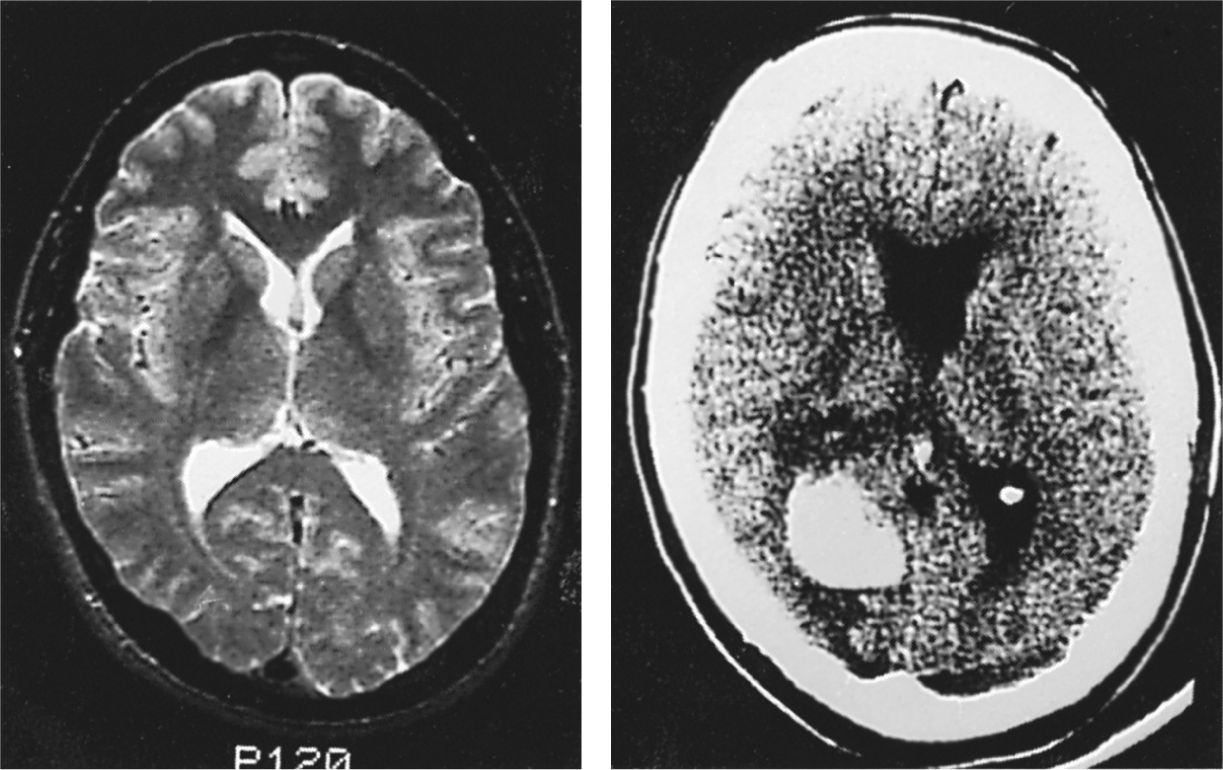
a. Right homonymous hemianopsia
b. Left homonymous hemianopsia
c. Loss of intellectual and emotional processes
d. Aphasia
e. Hemiparesis of the right side of the body
447. Based on the figure in Question 446, which of the following blood vessels was affected by the cerebrovascular accident?
a. Anterior cerebral artery
b. Middle cerebral artery
c. Posterior cerebral artery
d. Superior cerebellar artery
e. Striate arteries
448. The CT scan shown in the accompanying figure reveals that the patient has a glioma (T) on the right side of the brain. Which of the following has the patient most likely sustained?
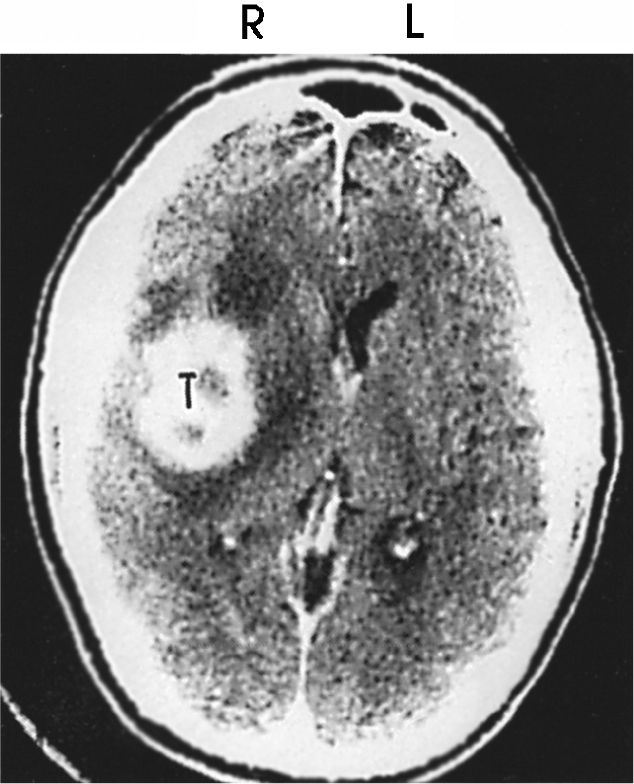
a. A UMN paralysis of the left side
b. Dyskinesia
c. Intention tremor
d. Upper left quadrantanopia
e. Upper right quadrantanopia
Questions 449 and 450
449. The patient, whose CT scan is shown in the figure, sustained an occlusion of a major artery on the left side of the brain. Which of the following deficits is most likely present in this patient?
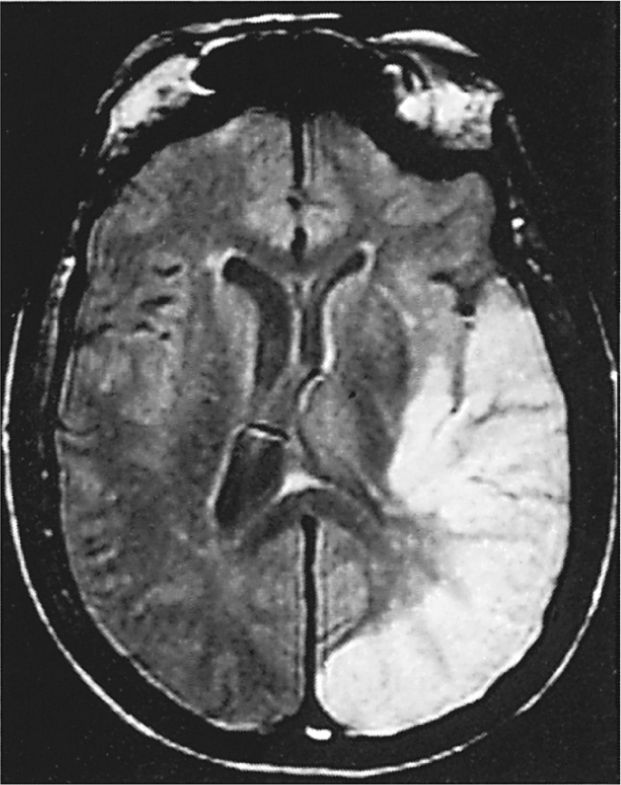
a. A right homonymous hemianopsia only
b. Aphasia only
c. A right homonymous hemianopsia coupled with aphasia
d. Marked intellectual deficits
e. Marked intellectual deficits coupled with hemiballism
450. In the figure in Question 449, which of the following blood vessels is occluded?
a. Anterior cerebral artery
b. Middle cerebral artery
c. Posterior cerebral artery
d. Posterior choroidal artery
e. Superior cerebellar artery
Questions 451 and 452
451. The vertebral angiogram in the given figure reveals the effects of a severe motorcycle accident upon a 21-year-old woman. As a result of the accident, from which of the following does she most likely suffer?
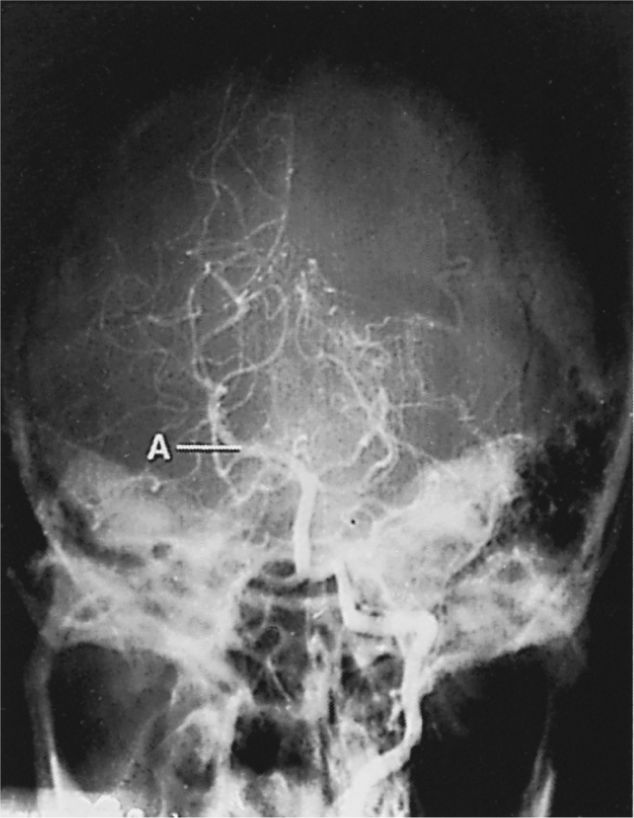
a. A UMN paralysis of the right side of the body
b. A right homonymous hemianopsia
c. A left upper quadrantanopia
d. Aphasia
e. Dyskinesia
452. In the figure in Question 451, which of the following arteries was occluded on the left side and labeled in the figure on the normal side as A?
a. Vertebral
b. Basilar
c. Middle cerebral
d. Anterior cerebral
e. Posterior cerebral
453. The MRI scan in the following figure reveals a large chromophobe adenoma (T) of the pituitary that impinges on the adjoining brain tissue. The patient suffered pituitary insufficiency as well as visual deficits. Which of the following dysfunctions is the result of this tumor?
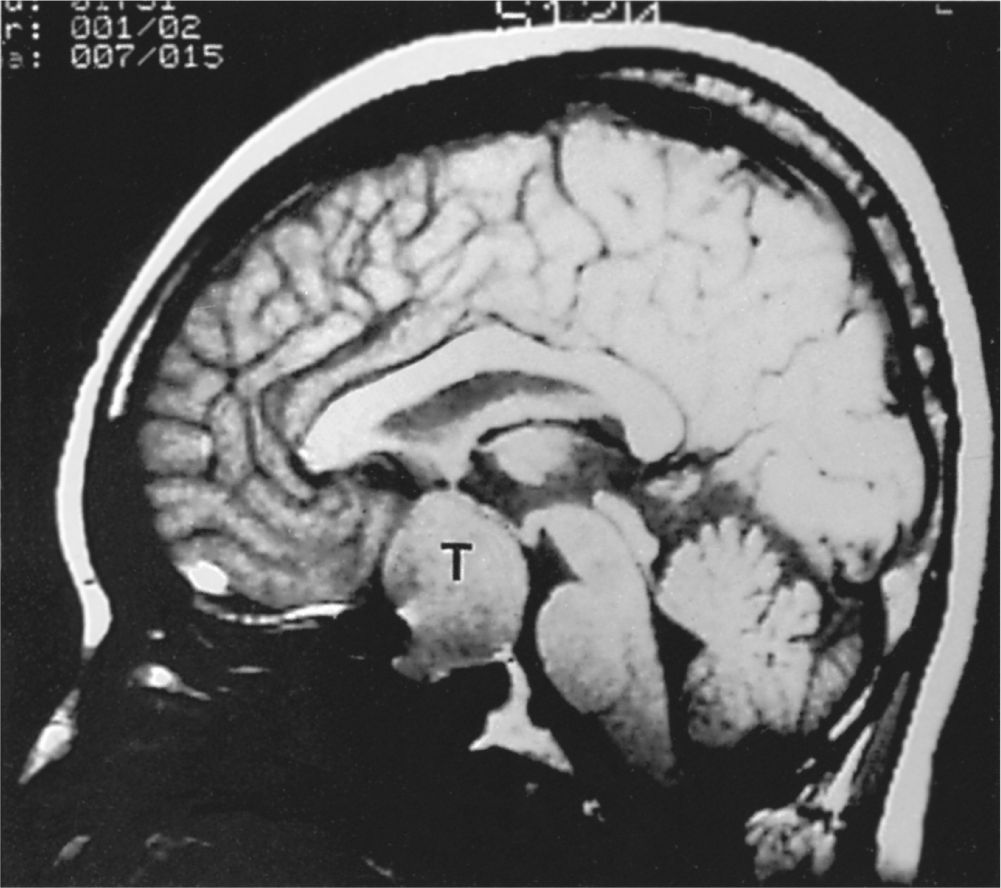
a. Binasal hemianopsia
b. Bitemporal hemianopsia
c. Loss of the accommodation reflex
d. Loss of the pupillary light reflex
e. Loss of conjugate gaze
454. A previously healthy 68-year-old woman experiences twitching of her left finger that soon extends to her hand, arm, shoulder, and then to her leg. At this point, she becomes unconscious. Her legs and arms began to jerk for several minutes and her neck extends backward. She does not respond to comments or requests by people who are near her. She is admitted to a hospital, at which time, she regains consciousness but is able to answer some questions such as identifying the present month. She has better movement of right side of her body than her left but is somewhat ineffective in following commands given by her physician. From which area of the brain did the seizure most likely begin?
a. Left precentral gyrus
b. Right precentral gyrus
c. Right temporal lobe
d. Left temporal lobe
e. Thalamus
455. An animal preparation is used for the study of the electrophysiological properties associated with epileptic seizures in which the type of potentials essential for the initiation of seizures is identified. Which of the following bursts of potentials noted in this study is linked to the initiation of seizures?
a. Inhibitory postsynaptic potentials (IPSPs)
b. Membrane potentials
c. Resting potentials
d. Excitatory postsynaptic potentials (EPSPs)
e. Nernst potential
456. A 32-year-old man is suffering from epilepsy and is administrated a drug that could antagonize the basic neurochemical process associated with the generation of seizures. Which of the following is the most likely mechanism for the generation of seizures for which drug therapy could apply?
a. Na+ channel blockade
b. γ-Aminobutyric acid (GABA) inhibition
c. Glutamate inhibition
d. Aspartate inhibition
e. Substance P inhibition
457. A 76-year-old woman who has a 10-year history of high blood pressure and diabetes is reaching for a jar of flour to make an apple pie, when her right side suddenly gives out, and she collapses. While trying to get up from the floor, she notices that she is unable to move her right arm or leg. She attempts to cry for help because she is unable to reach the telephone; however, her speech is slurred and rather unintelligible. She lies on the floor and waits for help to arrive. Her son begins to worry about his usually prompt mother when she does not arrive with her apple pie. After several attempts to telephone her apartment without getting an answer, he drives there and finds her lying on the floor. She attempts to tell him what had happened, but her speech is too slurred to comprehend. Assuming that his mother has had a stroke, the son calls an ambulance. A neurology resident is called to see the patient in the emergency room because the physicians there likewise thought that she had a stroke. The resident notes that she follows commands very well, and, although her speech is very slurred, it is logical in organization. The lower two-thirds of her face droops on the right. Her tongue points to the right side when she is asked to protrude it. Her right arm and leg are severely, but equally, weak; her left side has normal strength. She feels a pin and a vibrating tuning fork equally on both sides. Where in the central nervous system (CNS) did her stroke most likely occur?
a. Left precentral gyrus
b. Right precentral gyrus
c. Left basilar pons or left internal capsule
d. Right putamen or globus pallidus
e. Left thalamus
458. An elderly male patient in a hospital suffers an extensive stroke following a procedure to repair a defect in a heart valve. When the patient regains consciousness, a neurological examination reveals a paralysis of his left arm and leg, as well as inability to recognize a pin prick or tuning fork on his left leg or arm. Other sensory and motor functions of the face appear normal. Which of the following constitutes the most likely regions damaged by the stroke?
a. Prefrontal and primary motor cortices
b. Primary motor and somatosensory cortices
c. Premotor and posterior parietal cortices
d. Genu of internal capsule
e. Inferior and middle frontal gyri
459. An elderly male suffers a stroke that appears to involve the left internal capsule rather than the cerebral cortex. It results in paralysis of the right arm and leg, the tongue deviates to the right side when he is asked to protrude it; lower (jaw) facial expression on the right side is lost, and his speech is slurred, but fluent and grammatically correct. Which of the following best describes the speech deficit in this patient?
a. Wernicke aphasia
b. Broca aphasia
c. Anomia
d. Dysarthria
e. Conduction aphasia
Questions 460 and 461
460. A 12-year-old girl has no history of medical problems. One day, while in the kitchen with her mother, she tells her mother that she feels very frightened all of a sudden and has a funny feeling in her stomach. Immediately after this, she turns her head to the right, stares persistently, and begins to chew. Her mother calls her name several times, but the girl who was usually very obedient, does not answer. After approximately 1 minute of staring, she slowly turns her head back to her mother. Apparently confused, she asks her mother where she was. Over the next 10 to 15 minutes, she becomes less and less confused, and by the time she is in the car being driven to the pediatrician by her mother, she feels like she is back to normal. The pediatrician listens to patient’s mother’s story when they arrive. He examines the patient and finds no abnormalities on general physical examination or on neurological examination. The pediatrician tells her mother that he would refer her daughter to a pediatric neurologist for further evaluation, as well as further evaluation of the need for medication. Which of the following is the most likely diagnosis?
a. Attention deficit disorder (ADD)
b. Temporary psychosis
c. Conversion disorder
d. Epilepsy
e. Schizophrenia
461. In the diagnosis in Question 460, from which area of the brain is this problem most likely emanating?
a. Medulla
b. Occipital lobe
c. Temporal lobe
d. Thalamus
e. Midbrain
Questions 462 and 463
462. A patient has been suffering from a rare degenerative disorder that selectively destroys neurons of the hippocampal formation. As a result, there is a significant loss of inputs into regions of the forebrain that normally receive information from the hippocampal formation. Which of the following groups of structures are directly affected by the loss of neurons in the hippocampal formation?
a. Septal area, anterior thalamic nucleus, mammillary bodies
b. Cingulate gyrus, amygdala, mediodorsal thalamic nucleus
c. Habenular complex, globus pallidus, caudate nucleus
d. Septal area, olfactory tubercle, cingulate gyrus
e. Mammillary bodies, mediodorsal thalamic nucleus, paraventricular nucleus
463. In the patient in Question 462, which of the following is most likely to develop?
a. Hemiparesis
b. Diminished memory function
c. Diminished sensation
d. Improved attention
e. Dyslexia
Questions 464 and 465
464. One morning, an 82-year-old man finds that it is difficult for him to walk as his left foot collapses. He calls 911 for assistance and notices that his speech is slurred. The emergency room physician notes, in addition to his speech, the following deficits: His left arm and leg are markedly weak and muscle tone is flaccid. Reflexes are depressed on the left side but normal on the right side. All sensory modalities are depressed on the left side. The left side of his face droops and he consistently looks to the right side. When asked to look to the left, his eyes would not move beyond the mid-line. Likewise, when asked to raise his left hand, he raises his right hand. When asked if his left hand belongs to him, he replies that it does not. The physician draws a circle depicting a clock and the patient is asked to fill in the numbers in the clock. The numbers 1 through 12 are all placed on the right side of the clock. The physician also asks the patient to draw a vertical line that bisected a horizontal line drawn by the physician. The patient draws a vertical line on the right side of the line. When the physician waves his hand in front of the temporal visual field of the left eye or the nasal visual field of the right side, the patient does not blink. Aside from the drooping of the left side of the face (in which the forehead was spared), other cranial nerve functions appear normal. The physician orders a CT scan of the patient’s head and then admits him to the hospital for further testing. Which of the following neurological deficits does the patient display?
a. Left hemiparesis, hemineglect, left homonymous hemianopsia, left hemisensory loss
b. Left hemiparesis, right superior quadrantanopsia
c. Left hemiparesis, left hemisensory loss, hemineglect, left superior quadrantanopsia
d. Left hemisensory loss, hemineglect, bitemporal hemianopsia
e. Left hemisensory loss, hemineglect, left superior quadrantanopsia
465. In the patient in Question 464, where in the nervous system has the damage most likely occurred?
a. Left temporal and parietal lobes
b. Right frontal and temporal lobes
c. Right frontal and parietal lobes
d. Left frontal and parietal lobes
e. Left occipital lobe
466. An elderly female patient suffers a stroke resulting in weakness of her left limbs, reduced reflexes in those limbs, inability to gaze to the left and loss of facial expression on the left side, and failure to verbally acknowledge that anything is wrong with the left arm or leg. In this patient, which of the following is most likely occluded?
a. Right anterior cerebral artery
b. Left anterior cerebral artery
c. Right posterior cerebral artery
d. Right middle cerebral artery
e. Left middle cerebral artery
467. A patient is diagnosed with sensory neglect because he is unable to notice the left side of his body. Which of the following regions of the cerebral cortex is most likely damaged in this patient?
a. Left anterior frontal cortex
b. Right anterior frontal cortex
c. Right posterior frontal cortex
d. Right posterior parietal cortex
e. Right anterior parietal cortex
Questions 468 and 469
468. A 79-year-old man is brought to the emergency room because his family is worried that he suddenly is not using his right arm and leg and seems to have a simultaneous behavior change. He is unable to write a reminder note to himself, even with his left hand, and he put his shoes on the wrong feet. A neurologist is called to the emergency room to examine the patient. A loud bruit is heard with a stethoscope over the left carotid artery in his neck. When asked to show the neurologist his left hand, he points to his right hand, since it could not move. The neurologist asks him to add numbers, and he is unable to do this, despite having spent his life as a bookkeeper. The patient is unable to name the fingers on either hand, and he could not form any semblance of a letter using his left hand. The patient’s eyes do not blink when the neurologist waves his hands close to them in the left temporal and right nasal visual fields. The right lower two-thirds of his face droops. There is some asymmetry of his reflexes between the right and left sides, and there is a positive Babinski response of his right toe. Where in the CNS is the damage located?
a. Right frontal and parietal lobes
b. Left frontal and parietal lobes
c. Right frontal lobe
d. Left frontal lobe
e. Right temporal lobe
469. Assuming that the patient in Question 468 had a stroke, which of the following arteries has become occluded?
a. Left anterior cerebral
b. Right anterior cerebral
c. Right middle cerebral
d. Left middle cerebral
e. Left posterior cerebral
470. A 73-year-old man is admitted to a local hospital after he first begins complaining of headaches, which are then followed by a significant weakness in his right arm and leg, slurred speech, and lack of expression on the right side of the jaw. An MRI reveals the presence of a well-defined brain tumor (shown here). Which of the following structures or regions damaged by the tumor best accounts for the observed deficits?
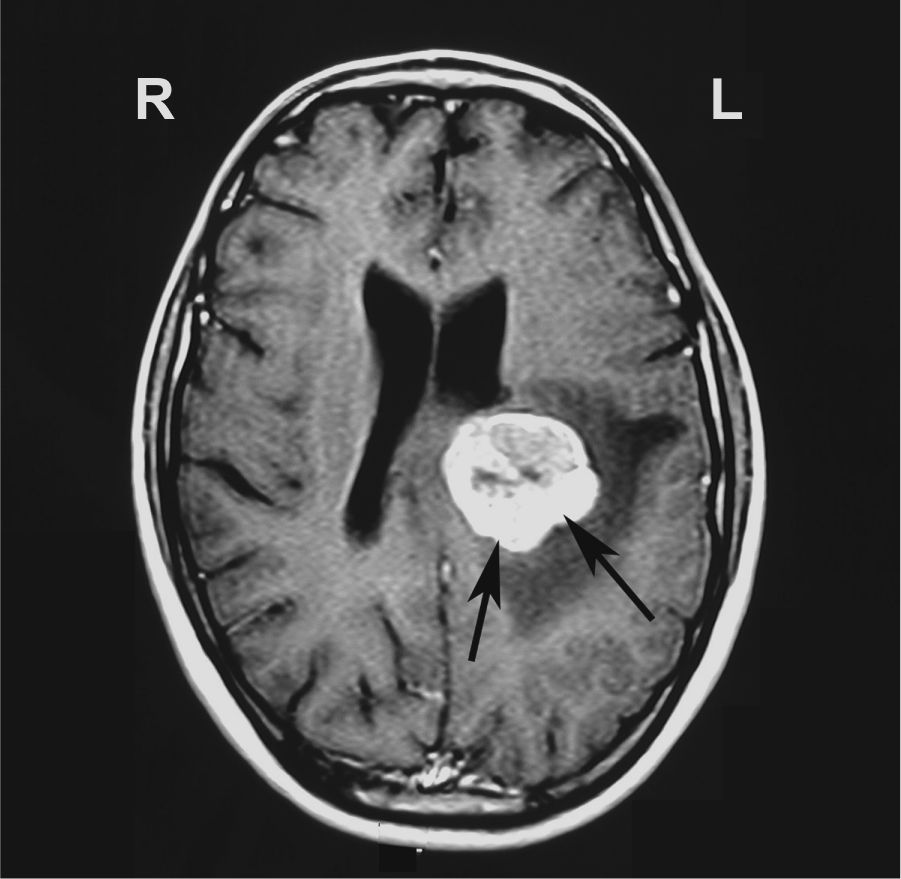
a. Caudate nucleus
b. Globus pallidus
c. Internal capsule
d. Temporal neocortex
e. Dorsal thalamus
471. The family of a 67-year-old woman notices that she is experiencing headaches, having difficulty completing mechanical tasks such as tying her right shoelace, and inability to voluntarily move her eyes to the right. After being hospitalized, an MRI (shown here) reveals the presence of a glioblastoma. Which of the following regions is primarily affected by the tumor that best accounts for the observed deficits?

a. Prefrontal cortex
b. Premotor region
c. Precentral gyrus
d. Basal ganglia
e. Posterior limb of internal capsule
Questions 472 and 473
472. A 75-year-old male college graduate is brought to a neurologist by his family because he is having problems with his gait, suffers from urinary incontinence (for the past 6 months), and recently began to have problems with his short-term memory and paying his bills. The gait problem manifests itself mainly as difficulty climbing stairs and frequent falls. The patient has no past medical history other than a subarachnoid hemorrhage resulting from a ruptured cerebral aneurysm many years earlier. When the neurologist examines him, she finds he cannot remember three objects 5 minutes after they are shown to him, even when prompted. He is unable to figure out how many quarters are in $1.75, and he spells the word “world” incorrectly. A grasp reflex (squeezing the examiner’s hand as a reflex reaction to stroking of the palm) is present. Although his motor strength is full in all of his extremities, when asked to walk, he takes many steps in the same place without moving forward, and then starts to fall. His cranial nerve, sensory, and cerebellar examinations are normal. The patient has a grasp reflex and dementia. A lesion in which of the following regions would most likely cause this deficit?
a. Occipital lobe
b. Frontal lobe
c. Medulla
d. Thalamus
e. Pons
473. You are asked to evaluate the patient with the neurologist. The nurse in the office asks if you would like to order a CT scan, and you request one. The CT scan shows that all the ventricles are dilated, especially the frontal horns of the lateral ventricles, without any evidence of obstruction by a tumor. Which of the following is the most likely mechanism underlying the enlargement of the ventricles?
a. Decreased cerebrospinal fluid (CSF) absorption
b. Low blood pressure
c. Decreased CNS blood flow
d. Decreased intracranial pressure
e. High blood pressure
474. A 38-year-old man is admitted to a hospital after losing consciousness on a number of occasions. During the periods in which consciousness is lost, it is reported that he displays stereotyped motor responses such as lip smacking and scratching. The patient reports to the neurologist that he seems to be in a “dreamy” state. He seems to experience an altered level of consciousness and feels as if he is detached from his present state of consciousness. At the same time, the patient has difficulty speaking, displays intense feelings of anxiety, and shows further signs of hallucinations such as flashing lights, voices of unknown people, or unpleasant smells. An MRI is taken (shown here) and a diagnosis is made. An EEG shows the presence of focal spikes, and high-voltage, slow-wave discharges. Which of the following is the most likely diagnosis?
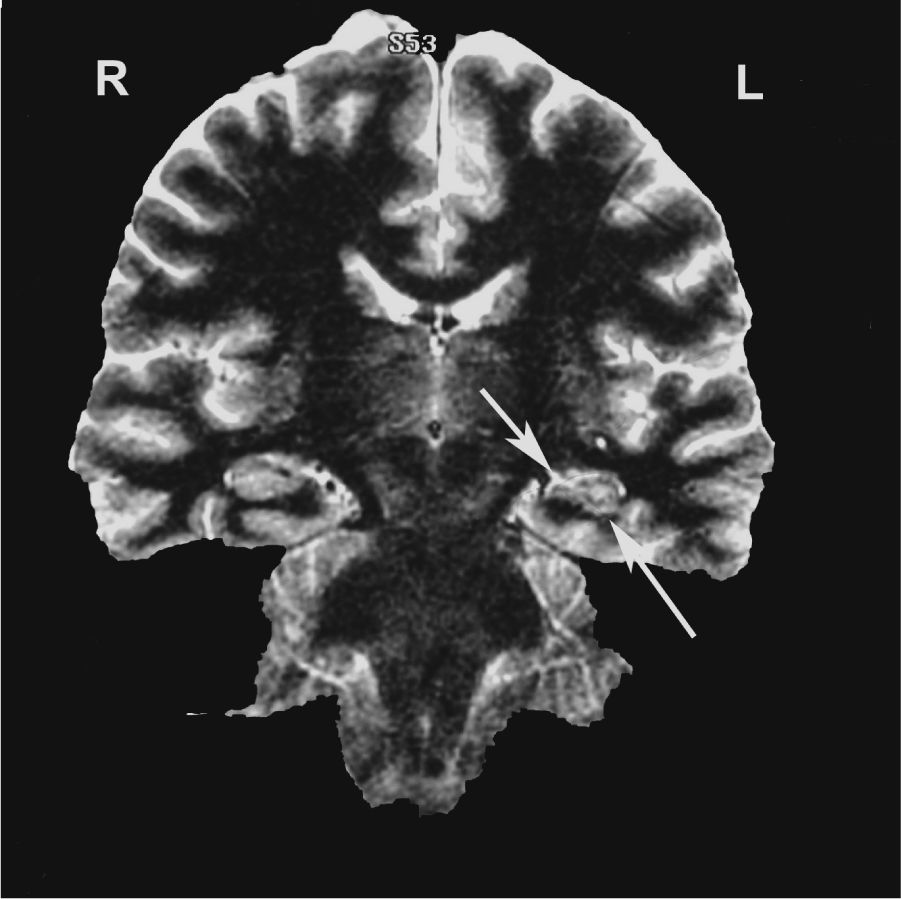
a. Absence seizures
b. Tonic-clonic seizures
c. Pseudoseizures
d. Complex partial seizures
e. Frontal lobe seizures
Questions 475 and 476
475. A 75-year-old man, who is right-handed, was told in the past by his internist that he has an irregular heartbeat. The patient decides that he does not wish to learn anything further about this condition, so he does not return to this physician, and it remains untreated. One morning, he awakes to find that his face droops on the right side and that he cannot move his right arm or right leg. When he tries to call an ambulance for help, he has a great deal of difficulty communicating with the operator because his speech is slurred, nonfluent, and missing some pronouns. The call is traced by the police; an ambulance arrives at his house and takes him to an emergency room. A neurologist is called to see the patient in the emergency room. When he listens to the patient’s heart, he detects an irregular heartbeat. It is very difficult to understand his speech because it is halting, with a tendency to repeat the same phrases over and over. He has difficulty repeating specific sentences given to him by the neurologist, but he is able to follow simple commands such as “Touch your right ear with your left hand.” His mouth droops on the right when he attempts to smile, but his forehead remains symmetric when he wrinkles it. He cannot move his right arm at all, but he is able to wiggle his right leg a little bit. Which of the following language problems does this patient have?
a. Dysarthria
b. Wernicke aphasia
c. Broca aphasia
d. Alexia
e. Pure word deafness
476. In the patient in Question 475, which area of the brain is most likely damaged?
a. Internal capsule and thalamus
b. Right occipital lobe
c. Pontine reticular formation
d. Corpus callosum
e. Left precentral gyrus and Broca area
477. A 69-year-old man is admitted to the emergency room after losing consciousness. When he regains consciousness, he is examined by a neurologist who concludes that there is an occlusion of one of the arteries supplying the brain. In addition, the neurologist records that the patient presents with a marked motor aphasia. Which of the following arteries is most likely occluded in this patient?
a. Anterior cerebral artery
b. Posterior cerebral artery
c. Anterior inferior cerebellar artery
d. Middle cerebral artery
e. Basilar artery
478. A 49-year-old man begins to act in ways that could be described as “antisocial,” coupled with what appeared to be intellectual deficits. He is sent for a neurological examination, given an MRI (shown in the figure), and then sent to a neuropsychologist for further examination. The patient is given a card-sorting task in which he is asked to sort the cards on the basis of color, shape, or number. The patient is unable to shift the categorization from shape to number when requested to do so. The patient also continues to perseverate in the use of original strategies in other problem-solving tasks even though those strategies are incorrect. The MRI (shown here) reveals the presence of a brain tumor. In this patient, what is the primary source of thalamic afferent fibers which project to the region containing the tumor?
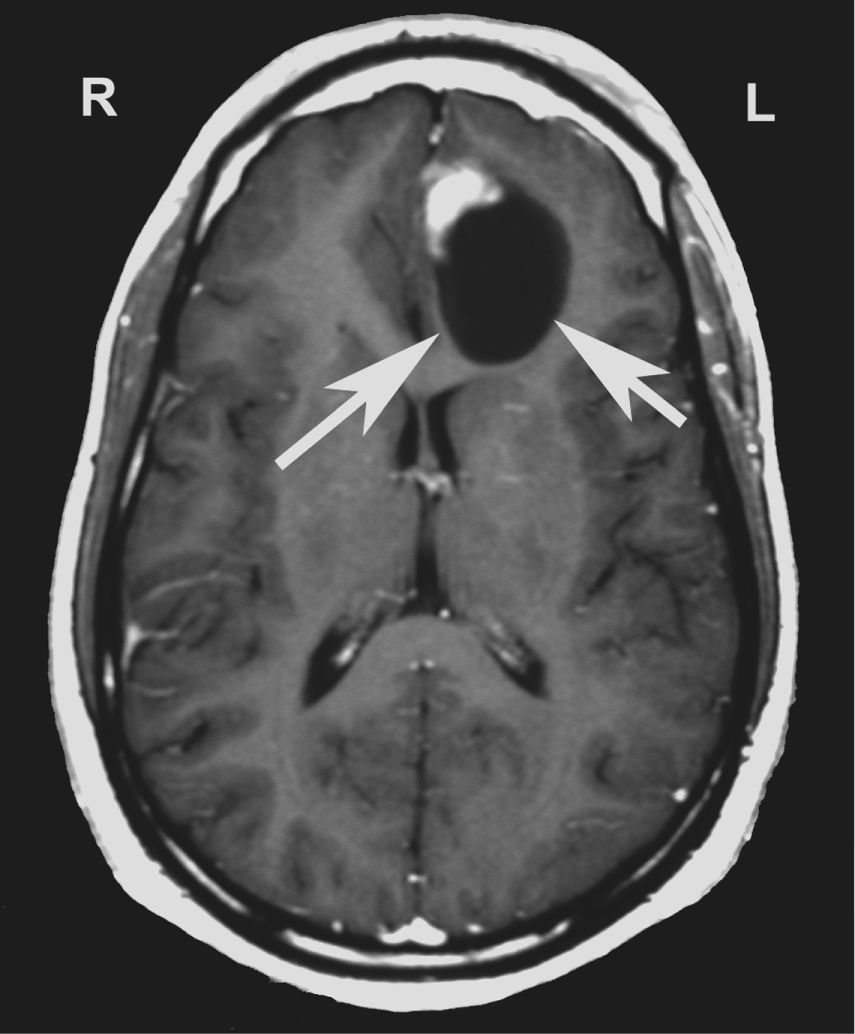
a. Anterior thalamic nucleus
b. VA thalamic nucleus
c. Dorsomedial thalamic nucleus
d. Pulvinar nucleus
e. Reticular nucleus
479. A 68-year-old man goes to a sleep clinic after experiencing repeated episodes of loud snoring during sleep, coupled with sudden periods of restlessness and cessation of breathing. After extensive analysis, the physicians conclude that the patient’s problem is not a result of obstructive sleep. Instead, it is judged that this condition reflects central sleep apnea due to loss of chemoreceptor sensitivity of the neuronal control mechanisms governing respiration. At which of the following sites within the CNS would a lesion produce these effects?
a. Dorsal horn of the thoracic spinal cord
b. Lateral medulla
c. Midbrain periaqueductal gray
d. Amygdala
e. Parietal-occipital juncture
480. Loss of consciousness would most likely result from a lesion of which of the following regions?
a. The region surrounding the cervical spinal cord
b. Supratentorial components of the cranium
c. Ependymal region of the lateral ventricle adjoining the caudate nucleus
d. The region confined to the lower (ventral) pons
e. The region of the left parietal cortex
481. A patient is treated by both a neurologist and psychiatrist. The patient’s disorder is characterized by the abrupt onset of changes in arousal from mild lethargy through dramatic agitation as well as impairment of one’s ability to think clearly and logically while still being able to respond in an appropriate manner to stimuli which are either internal or external. Which of the following best describes this disorder?
a. Dementia
b. Delirium
c. Korsakoff syndrome
d. Vegetative state
e. Stupor
482. A 64-year-old female patient presents with a reduction in fluency of speech with a serious deficiency in naming of objects and repetition of words when requested to do so. The patient’s writing is poor and she also displays a hemiparesis. Comprehension of speech appears to be preserved. An MRI and overall neurological examination reveal that the patient has a lesion. Which of the following regions is likely to contain the lesion?
a. Medial convexity of the premotor cortex
b. Frontal operculum and convexity
c. Supramarginal gyrus
d. Angular gyrus
e. Inferior parietal lobule
483. A 67-year-old woman is brought to a local hospital following complaints by her family because of recent difficulties that the patient has experienced in communicating with others. In particular, the patient has great difficulty in comprehending words and understanding simple commands. A neurological examination confirms that the patient experiences difficulties in language comprehension and an MRI reveals a cortical lesion. Which of the following regions was observed to be the locus of the lesion?
a. Medial convexity of the premotor cortex
b. Frontal operculum and convexity
c. Medial aspect of occipital cortex
d. Posterior aspect of superior temporal lobe
e. Superior (posterior) parietal lobule
Stay updated, free articles. Join our Telegram channel

Full access? Get Clinical Tree







